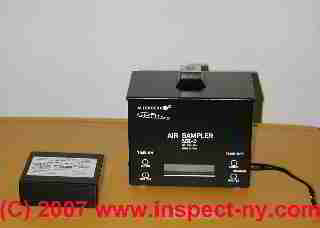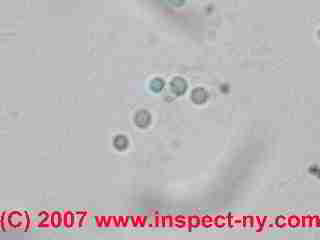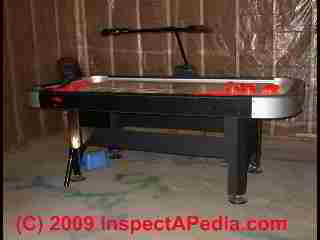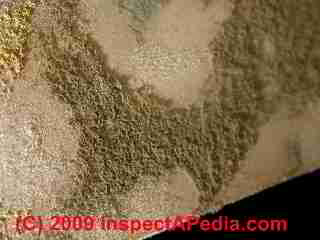 Particle Levels vs Sampler Height Variations When Air Sampling for Mold
Particle Levels vs Sampler Height Variations When Air Sampling for Mold
- POST a QUESTION or COMMENT about how air sampler location or height above floor affects airborne particle count results
Effects of air sampler height on particle collection & counts per cubic meter:
This article discusses mold or airborne particle levels versus air sampler height when testing for airborne mold or other airborne particulates.
This document is a brief tutorial that provides information about the accuracy of and sources of errors in tests for the level of allergenic and toxic mold in residential buildings: Are spore counts valid? Are cultures and swab tests valid? These critical questions are discussed in this paper.
InspectAPedia tolerates no conflicts of interest. We have no relationship with advertisers, products, or services discussed at this website.
- Daniel Friedman, Publisher/Editor/Author - See WHO ARE WE?
Variation in Airborne Particle Levels due to Placement Height of Air Sampling Device

How much difference does it make whether the air sampling machine is placed on top of or underneath a mold-contaminated table?
The photographs above and below show microphotographs of representative sections of an airborne particle sample trace in the same room in a building, with a single variation: the first photograph (above) of a mold spore sample shows just a few fungal spores was collected with our sample placed on top of a basement pool table.
The second photo (below) photo of a mold spore trap sample shows a very high spore concentration in the same room, obtained when we placed our sampler on the floor below the (mold infected) pool table. In both samples we used passive methods.
Our photos just below show a game table left in a basement where an airborne mold problem was suspected.
The table looked "clean" but inspecting below (see our flashlight leaning on the left table leg?) shows thick yellow and green mold growth on the un-sealed chipboard structure.

Had we stirred room air (say by turning on a fan or waving a notebook, it is likely that these "under table" mold spores would have been distributed more uniformly in the building's indoor air and that they would have been present in an air sample at a much higher level than with passive spore trap air sampler use.
Many IAQ consultants place their air sampler at about chest or head height in a building, presuming that will best represent the particles that will be inhaled by building occupants.
This sounds reasonable except that mechanical disturbance of local indoor dust will cause enormous variation in the actual particle level at any given time and will probably make the particle distribution more uniform in the space.
Our field and lab experiments show one to three orders of magnitude (or more) variation in airborne spore counts at the same location depending on the use of passive or aggressive sampling methods.
How many mold reports document the details of sampling such as where mold was visible, where the sampler was placed, and what possible variations in airborne particle level might obtain depending on details of how the sample was collected such as whether fans are turned on or off, the room was occupied or empty, windows open or shut, vacuum cleaners running, children playing nearby, etc.
Virtually never is this information considered, gathered, or reported by the industrial hygienist or other mold investigator in residential indoor air quality investigations.
How to Interpret Airborne Mold Tests in View of Air Sampling Inaccuracy
We conclude that if an indoor air test for mold such as using a spore trap or air sampling device detects a high level of problem mold spores (or other airborne particles) we believe that those results have meaning and indicate a problem
- although that type of test alone is faulty because it is not prescriptive: we still have not identified the source of the problem so we still do not know what action is needed.
Watch out: if an indoor air test for mold does not detect a high level of airborne mold or other problem particles, we cannot rely on this procedure alone to reach a confident conclusion about the air quality in the building.
...
Continue reading at ACCURACY OF AIR TESTS for MOLD - home or select a topic from the closely-related articles below, or see the complete ARTICLE INDEX.
Or see these
Recommended Articles
- ACCURACY vs PRECISION of MEASUREMENTS
- ACCURACY OF AIR TESTS for MOLD
- AIRBORNE PARTICLE TEST SAMPLING CASSETTE STUDY
- AIRBORNE MOLD SPORE COUNT GUIDE - home
- AIRBORNE PARTICLE LEVELS vs IAQ - home
- AIRBORNE MOLD COUNT VALIDITY
- AIRBORNE PARTICLE ANALYSIS METHODS
- AIRBORNE PARTICLE COUNT VARIATION CAUSES
- AIRBORNE PARTICLE COUNT VARIATION EXTENT
- AIRBORNE MOLD SPORES CONCENTRATION BURSTS
- AIRBORNE PARTICLE COUNT VARIATION EXTENT
- AIRBORNE MOLD COUNTS INDOOR vs OUTDOOR
- AIRBORNE PARTICLE COUNTS in DUCTWORK
- AIRBORNE PARTICLE COUNTS vs SAMPLER HEIGHT
- AIRBORNE PARTICLE COUNTS vs WINDOWS, DOORS
- ACCURACY of MOLD TESTS
- ENVIRONMENTAL TEST ERROR TYPES
- FALSE NEGATIVE MOLD TEST RESULTS
Suggested citation for this web page
AIRBORNE PARTICLE COUNTS vs SAMPLER HEIGHT at InspectApedia.com - online encyclopedia of building & environmental inspection, testing, diagnosis, repair, & problem prevention advice.
Or see this
INDEX to RELATED ARTICLES: ARTICLE INDEX to MOLD CONTAMINATION & REMEDIATION
Or use the SEARCH BOX found below to Ask a Question or Search InspectApedia
Ask a Question or Search InspectApedia
Try the search box just below, or if you prefer, post a question or comment in the Comments box below and we will respond promptly.
Search the InspectApedia website
Note: appearance of your Comment below may be delayed: if your comment contains an image, photograph, web link, or text that looks to the software as if it might be a web link, your posting will appear after it has been approved by a moderator. Apologies for the delay.
Only one image can be added per comment but you can post as many comments, and therefore images, as you like.
You will not receive a notification when a response to your question has been posted.
Please bookmark this page to make it easy for you to check back for our response.
IF above you see "Comment Form is loading comments..." then COMMENT BOX - countable.ca / bawkbox.com IS NOT WORKING.
In any case you are welcome to send an email directly to us at InspectApedia.com at editor@inspectApedia.com
We'll reply to you directly. Please help us help you by noting, in your email, the URL of the InspectApedia page where you wanted to comment.
Citations & References
In addition to any citations in the article above, a full list is available on request.
- Thanks to Susan Flappan, Flappan Consulting, moldetect.com, Overland Park KS, 913-402-1131, for contributing comments and some suggested text from ACGIH Bioaerosols: Assessment and Remediation 12/2006.
- Our recommended books about building & mechanical systems design, inspection, problem diagnosis, and repair, and about indoor environment and IAQ testing, diagnosis, and cleanup are at the InspectAPedia Bookstore. Also see our Book Reviews - InspectAPedia.
- Carson, Dunlop & Associates Ltd., 120 Carlton Street Suite 407, Toronto ON M5A 4K2. Tel: (416) 964-9415 1-800-268-7070 Email: info@carsondunlop.com. Alan Carson is a past president of ASHI, the American Society of Home Inspectors.
Thanks to Alan Carson and Bob Dunlop, for permission for InspectAPedia to use text excerpts from The HOME REFERENCE BOOK - the Encyclopedia of Homes and to use illustrations from The ILLUSTRATED HOME .
Carson Dunlop Associates provides extensive home inspection education and report writing material. In gratitude we provide links to tsome Carson Dunlop Associates products and services.



